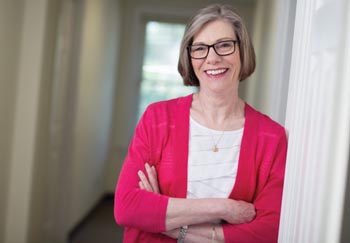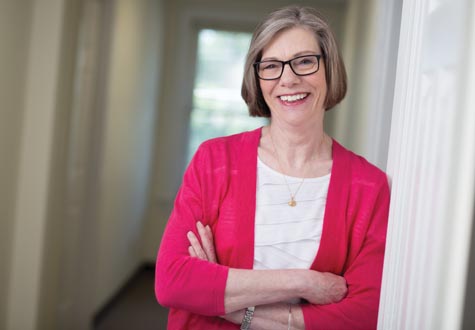
Chris Payne underwent breast cancer screening every year, and she had never had any issues. She had no family history of breast cancer and was in good health. In 2016, doctors found a cyst and easily treated it.
So when Payne went for her mammogram the following year, at age 61, she wasn’t worried. Even when the doctor’s office called and asked her to come back for another image of her right breast, she figured it might just be another cyst.
Then, her providers said she needed a breast biopsy. Payne noticed the worried expressions on their faces. “I’m thinking, ‘you guys are changing the feel in the room,’” she recalls.
They sent the biopsy to another hospital. Getting the results took almost three weeks.
A Diagnosis: Estrogen-Receptor Positive Breast Cancer
Initially, Payne’s doctor told her she had cancer and needed a lumpectomy, a surgery that removes the tumor but preserves the breast. Then the news got worse. They began talking about a mastectomy, then “suspicious lymph nodes.”
“It became really scary,” Payne says. But she told herself, “I have a lot of control with this. There’s a lot of information available. There’s things I can do to help myself; there’s things I can do to help my doctors.”
Payne had two low grade, stage 1 tumors in the same breast, meaning the cancer was slow-growing and contained in her breast and was, in fact, not in her lymph nodes. Her tumors were estrogen-receptor positive, meaning the surface of the cells had estrogen receptors. These kinds of tumors grow more slowly but can recur years later, according to the American Cancer Society.
Payne’s doctor recommended a mastectomy, a procedure to remove her right breast. But because of the slow-growing nature of these tumors, she didn’t need surgery right away. Instead, she and her husband kept their vacation plans for that summer; she didn’t have surgery until November.
Mastectomy and DIEP Flap Reconstruction
Payne considered treatment at her local community hospital, where doctors had diagnosed her. However, she followed her primary care provider’s recommendation to get a second opinion at UVA, which is about an hour away from her home in Sperryville, Va. There, she learned she could get a DIEP flap reconstruction procedure.
Breast Care Resources
Unsure of your risk? Use the NCI’s breast cancer risk assessment tool.
High risk? Find out what that means & make an appointment with our high-risk breast cancer program.
Interested in 3D mammograms? Low-dose breast tomosynthesis improves breast cancer detection for 90 percent of women.
Can’t afford a mammogram? Every Woman’s Life may be able to help. Call 434.243.9782 to find out if you qualify.
DIEP flap procedures replace the skin and fat of your breast with skin and fat from the abdominal area. Another, more common, procedure uses muscle from the abdomen, robbing patients of abdominal function. Depending on whether they lost one or both breasts, 20 to 50 percent of those patients can’t do a sit-up afterward. After the DIEP flap procedure, more than 90 percent of patients can do a sit-up, explains Chris Campbell, a UVA breast reconstruction plastic surgeon. Additionally, since the breast consists of skin and fat, it grows larger or smaller as a woman’s weight changes.
Recovery After Breast Surgery
Payne, Campbell recalls, “flew through this.” After her mastectomy and reconstruction, she was part of UVA’s Enhanced Recovery After Surgery Program, which helps patients recover and go home faster. As part of that, she received a nerve-blocking medicine that can provide full pain relief for up to 72 hours after the procedure, Campbell says. This helps patients avoid other painkillers that can cause nausea and vomiting.
Payne also participated in a study where patients wear a tracking device similar to a Fitbit that tracks steps, sleep and heart rate and asks the patient questions about their sleep and pain pill usage. Ultimately, Campbell hopes such monitoring and real-time communication will be standard.
Payne was also interested in gene expression testing. After surgery, this test, which is only for hormone-receptor positive tumors like Payne’s, looks at the likelihood of the tumor returning. Doctors use this information to decide whether the patient needs chemotherapy or not.
Christiana Brenin, Payne’s oncologist, says UVA has been doing this test for about three years. “It keeps us from treating a lot of women who wouldn’t benefit from chemotherapy,” she says. That helps them regain their quality of life sooner and spares them from severe side effects and long-term effects of chemotherapy.
In Payne’s case, the test indicated she didn’t need chemotherapy. She was thrilled. “The thought of chemo scared me to death,” she said.
Payne’s Goal: Encouraging Breast Cancer Screening
Payne continues to see her oncologist every six months and also sees her surgeon, David Brenin, on a rotating cycle. She’ll need to take a hormone inhibitor until seven years after her surgery. It’s hard to officially say she’s cured, Brenin says, because estrogen-receptor positive tumors can recur up to 20 years later. But most patients who had these tumors are indeed cured.
Need a Mammogram?
UVA doctors recommend annual mammograms for women 40+ or who are high-risk. Learn more about the exam and make an appointment.
However, Payne and her doctors agree that she was lucky to avoid chemo and have such a smooth recovery.
“I hope I never lose my appreciation for the gift that I’ve been given in this,” Payne says. “Every day’s got some blessings, and every day is a gift.”
She’s also made it her mission to encourage others to be proactive about their health, do research after a diagnosis and get an annual breast cancer screening. (UVA doctors recommend annual mammograms for women 40 and over or higher-risk younger women.)
“I don’t want the cancer to define me; it’s just something that happened to me,” Payne says. “But what I do want to do is tell people ‘this is not a death sentence.’ In my opinion, cancer treatment is changing. It will become less barbaric than it was, and people need to realize it’s not a death sentence.”
